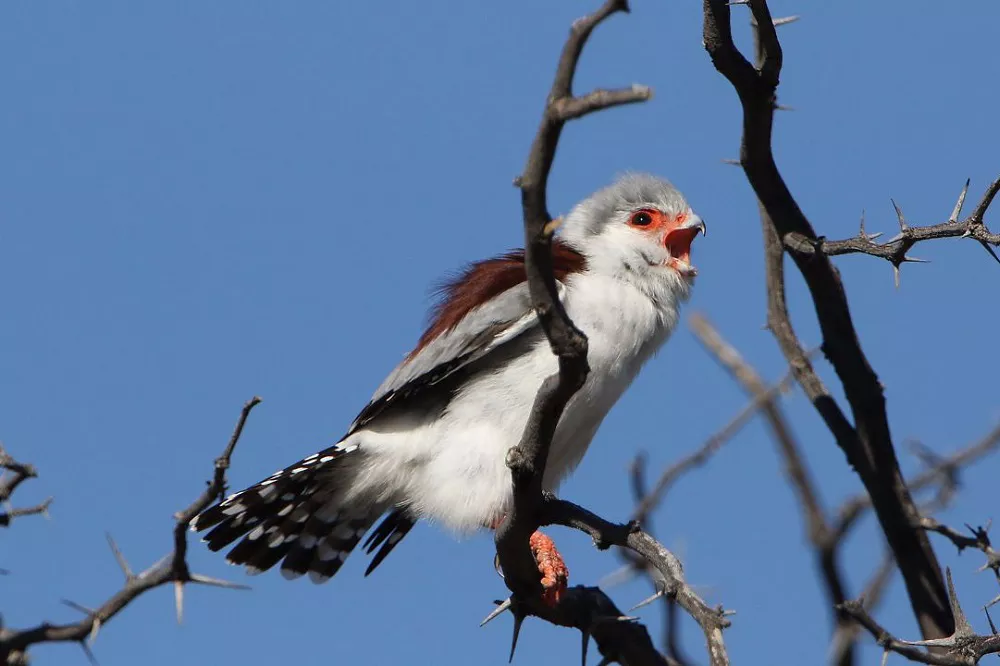Pygmy falcons (Polihierax semitorquatus) are fascinating birds of prey known for their diminutive size and impressive hunting abilities. Despite their small stature, these avian predators possess remarkable adaptations that enable them to thrive in their natural habitats. In this article, we delve into the size and physical characteristics of pygmy falcons, shedding light on their unique attributes and highlighting their exceptional hunting prowess.
Physical Size
Pygmy falcons are renowned for their petite stature, making them one of the smallest falcon species in the world. Let’s explore their size in more detail:
-
Length and Wingspan:
On average, pygmy falcons measure around 16-18 centimeters (6.3-7.1 inches) in length. Their compact size is complemented by a wingspan of approximately 32-35 centimeters (12.6-13.8 inches). This modest wingspan allows for agile flight and maneuverability, essential for their hunting techniques.
-
Weight:
Pygmy falcons are incredibly lightweight, typically weighing between 35-50 grams (1.2-1.8 ounces). Their lightweight build allows them to navigate swiftly through their habitat, making quick aerial maneuvers and capturing prey with precision.
Distinctive Features
In addition to their small size, pygmy falcons possess several unique features that distinguish them within the falcon family:
-
Coloration:
Pygmy falcons exhibit sexually dimorphic plumage. The males feature a striking combination of light blue-grey upperparts and a white underbelly. Their faces are adorned with a distinctive black eye stripe and a rufous-colored patch on the nape. Females, on the other hand, have a more muted coloration with brownish upperparts and a pale underbelly. The black eye stripe is also present in females but is less pronounced compared to males.
-
Beak and Talons:
Despite their small size, pygmy falcons possess sharp and powerful beaks and talons. Their beaks are curved and hooked, ideal for tearing into prey and extracting meat. Their talons are strong and agile, allowing them to grasp and secure their quarry effectively.
Hunting Abilities
Pygmy falcons are highly skilled hunters, capable of capturing a variety of prey. Despite their diminutive size, they exhibit exceptional hunting techniques and strategies:
-
Insectivorous Diet:
The primary diet of pygmy falcons consists of insects, particularly termites. They have developed a unique hunting relationship with sociable weaver birds, as they often nest within the large, elaborate nests created by these birds. Pygmy falcons take advantage of the abundant insect population found around these nests, swooping down to capture termites in mid-air or foraging for them on the ground.
-
Agile Flight:
Pygmy falcons display incredible agility and aerial prowess. They are known for their rapid flight, darting and maneuvering swiftly to capture prey in mid-air. Their small size and lightweight build allow them to navigate through intricate habitats with ease, making them adept at pursuing and capturing fast-moving insects.
Size Comparison with Other Falcons
Pygmy falcons are significantly smaller than other falcon species such as the peregrine falcon or the gyrfalcon. A peregrine falcon, for example, can measure up to 50 centimeters in length and weigh up to 1,500 grams. This makes them around three times larger than pygmy falcons.
Another falcon species that pygmy falcons are often compared to is the American kestrel. While both birds are considered small falcons, the American kestrel is still larger than the pygmy falcon, measuring between 20 and 30 centimeters in length and weighing between 80 and 150 grams.
Conclusion:
Pygmy falcons, despite their petite size, possess a unique set of physical characteristics and hunting abilities that enable them to thrive as skilled predators. Their small stature, distinct plumage, and agile flight make them a captivating species within the falcon family. By specializing in an insectivorous diet and exhibiting exceptional aerial agility, pygmy falcons exemplify the remarkable adaptations found in nature. Appreciating the remarkable size and abilities of pygmy falcons deepens our understanding of the diverse range of avian species and their intricate ecological roles.
Related topics:
- What is a Pygmy Falcon?
- What do Pygmy Falcons eat?
- What type of beak does an African Pygmy Falcon have?
- What is the smallest falcons in the world?


 Facebook
Facebook  Instagram
Instagram  Youtube
Youtube 